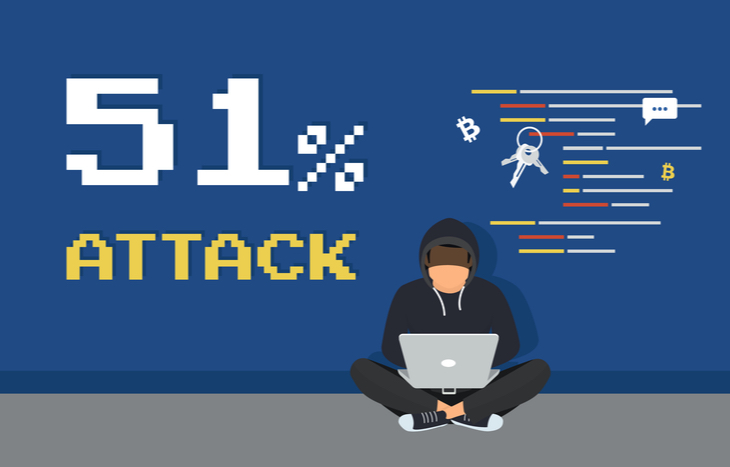What Is a 51 Attack?

Cryptocurrency—or, more specifically, blockchain—is widely touted for its relative infallibility. Thanks to the distributed nature of blockchain ledgers and decentralized nature of crypto, no single person or entity can manipulate the blockchain. That is, unless they stage a 51 attack.
What is a 51 attack? It’s a very complex endeavor to control the hashing power of a blockchain, and it’s the closest thing to bitcoin fraud possible.

The Definition of a 51% Attack
A 51 attack is so named because it involved taking over a majority of the hashing power within a network. More specifically, at least 51% of the hashing power. To understand what this means, you need to understand how the blockchain works.
Miners manage decentralized crypto blockchains. These are computers responsible for verifying the complex hashes that represent transactions on the blockchain. Miners work in “pools” to leverage computing power, since there are so many transactions that need verification. Their purpose is simple: to verify that the transaction taking place is valid. They do this by verifying previous entries to ensure the person selling the crypto assets actually has them.
If a majority of miners verify the transaction, it’s recorded on the blockchain. If they reject it, it’s not added to the ledger. This means that anyone who wants to manipulate the blockchain for malicious purposes would need to control at least 51% of the mining power.
What’s the Outcome of a Successful 51 Attack?
There are several major outcomes to consider in the event of a successful 51% attack—none of them good. Controlling the majority of computing power in a miner pool gives the malicious agent a significant amount of power. Here’s what the effects might look like:
- Double-spend. With the ability to self-confirm or -deny transactions, a malicious actor could double-spend crypto within the blockchain. They’d do this by recording a transaction from Account A to Account B, then revising the blockchain to erase this transaction. Then, they’d re-record a transaction from Account A to Account C in the same amount. The ledger would register both transactions, but only represent the latter.
- Prevent confirmations. Controlling the ability to verify or deny transactions gives the 51% attacker control over the hashing of the blockchain. This means they’re able to deny legitimate transactions and approach malicious ones, effectively altering the proof of work log of the blockchain. This can fundamentally disrupt the ledger and alter all future transactions on it.
- Prevent coin generation. Miners are so-called because, in addition to managing the ledger, they also mine new coins. Controlling the majority of the hashing power can limit other miners in the pool from generating new coins. As a result, there’s inefficiency within the pool for as long as the 51% attack lasts.
These are the catalysts for even more headaches. Some crypto experts theorize that a successful 51% attack on major crypto asset could fundamentally undermine the entire currency, causing it to crash!
A Hypothetical Problem or a Real Concern?
The amount of computing power needed to execute a 51% attack is substantial. For major cryptocurrencies like Bitcoin and Ethereum, it’s nearly impossible for a pool to reach 51% of the computing power to control hash verifications. That said, there have been near-misses in the past.
In January 2014, Bitcoin was almost subject to an unintended 51% attack when the GHash.io pool reached 55% mining power. Thankfully, the situation was well-monitored and the pool’s computing power was redistributed to reduce the ratio. There was no malicious attempt—merely an unwanted consolidation of mining power within a single pool. After this incident, other pools quickly pared down computing power to redistribute it, lowering the total computing power within pools.
While Bitcoin, Ethereum and others are too large to attack, there’s a world of smaller cryptocurrencies out there that are highly susceptible to 51% attacks. In fact, since 2018, there have been several high-profile, successful attacks.
- Bitcoin Gold (BTG) was subject to 51% attacks that cost a cumulative $1,860,000.
- Zcash (ZEC) saw a 51% attack that resulted in a loss of $500,000.
- Verge (XVG) suffered a massive 51% attack that cost a cumulative $2,700,000.
The smaller and newer a cryptocurrency is, the fewer the number of miners. This paves the way for bad actors to take control over mining pools and reach hashing power in excess of 51%. Thankfully, attacks on new coins are rare due to the relatively low value of the coin (pennies or tenths of a cent).
This actually brings up an interesting alternative to a 51% attack. Instead of using the mining pool to attack the blockchain, bad actors could actually leverage the pool to mine for coin. For new currencies, it would actually be more lucrative to leverage the computing power of the mining pool to generate new coins, rather than try to double-spend or control the blockchain. In this way, coins are actually safe from 51% attacks while they’re smaller.
Is Crypto a Safe as it Seems?
Cryptocurrencies, such as Bitcoin and SafeMoon, come with a range of vulnerabilities and market volatility. However, that doesn’t mean you shouldn’t invest in crypto. In fact, expert Andy Snyder is on a crypto journey of his own and you can follow along by signing up for the Manward Financial Digest e-letter below.
So, what is a 51 attack exactly? Most crypto experts will tell you the same thing: it’s the only real threat to the integrity of crypto. The good news? For larger coins, it’s virtually impossible to mount such an attack. For small coins, it’s rarely worth it. This means, although not completely infallible, crypto remains one of the most secure investment assets thanks to its proof of work concept and the decentralized nature of the mining pools that oversee the blockchain.








10 Comments
tercüme bürosu
ukraynaca tercüman
latince ingilizce yeminli çevirmen
ivogsan tercüme
online tercüman
hemen çeviri
yeminli çeviri
diplomatic translation
text to speech
sesi yazıya çevirme